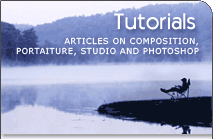This article belongs completely to Ed Shapiro, a professional photographer, who contributed a lot to the art. It is based on the content of a topic of forum. I have to thank Ed for covering this topic. I could not find any place where Ed gathered and published his knowledge, so I decided to extend the audience of the forum where he posted this topic. So here it goes...
There are GELS and then there GELS!
Optical filters are for use over the camera lens and are usually made of optical glass, optical grade plastic or GELATINE, hence the nickname gel. Gelatine filters for use in the optical path are of optical quality, yielding images free of distortion or interference They are however very fragile and are not intended for long term use — and they are somewhat expensive. They were very useful for colour correction and colour compensating with transparency films of yore because most professional reversal emulsions came with a suggested filter pack. The old Ektachrome, when used with electronic flash needed to be filtered quite heavily, to the tune of 20 red + 10 yellow as a typical starting point for testing. A good stock of filters was needed to be kept on hand in order to arrive at the exact filtration for each emulsion batch and particular job.. The gelatine filters are still manufactured by Kodak — but I seldom use them these days. Most Kodak and Fugi professional film need little or no filtration and what is needed can be handled by a few glass warming and cooling such as the 81A or 80B.
With lighting gels — special effects, color correction and compensation can be achieved by simply placing various gels over the lights. Theses filters are not made of gelatine but hold the same nickname as their optical counterparts and predecessors. This term is also applied to theatrical stage lighting.
Today's lighting gels are made of non-thermo-set plastics — which means that they are on a tough base that will not melt or burn under the high temperatures of incandescent lighting or modeling lamps in studio electronic flash units.
The best gels are made my ROSCO, of Hollywood , California and Port Chester , New York . There is also a branch in the UK .
They are a candy store of gels and reflective materials not to be equaled by any other company that I know of. They have swatch books with hundreds samples of each material along with the technical details of each as to transmission/wavelength specs and other useful information. Some of the sheets have built in diffusion properties. The reflection materials are to die for. The Roscoflex line has reflectors that have soft or hard properties and are available in a variety of colors as well.. The use of this stuff is only limited by your imagination.
A tip — Place a piece of #11130 in front of your portable (wedding) lights and say goodbye to cold wedding dresses — it absorbs UV and reduces Kelvin by 400 degrees.
Another tip — If you have to shoot a person in a factory or warehouse that is lit by fluorescent lamps or sodium lamps which would ordinarily cause an extreme shift to green or yellow/green — place a green gel such as Rosco — Tough WF GREEN on your portable flash units. Use Portra 400 NC or Fugi Reala colour-negative films - During printing — simply compensate for the excess green and the subject and the surroundings will normalize together. I gobo the subject so that very little or no ambient lights hits him and drag the shutter to pick up the background.
When I am trying to color a neutral background I choose a fairly rich filter like #71 (sea blue) and pump a lot of light through it. I test and mark each filter with the F/stop compensation needed to match my studio lighting set up and increase the power of the background lights accordingly.
In the attached image, the art director gave us a specific (pantone) color to change the color of a “dingy” machine — to match with a border color he was using in an annual report layout. With a scoop type reflector on out flash head we were able to “paint” the machine without changing the color of the walls or the technician.
Some semantics and some nuts and bolts — hope this helps. ![End of the article [end of the text]](http://www.romanzolin.com/img/misc/text_end_ed.png)





